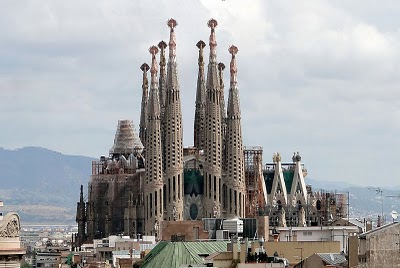Book Your Tickets For Barcelona!
By Nancy August 2nd, 2010
Gaudi was a Spanish architect during the Art Nouveau period (1890 – 1905) and many of his works can be seen in the city of Barcelona. His sensuous curving style is completely his own, but can be described as a kind of warped form of Gothic architecture. He was a devout Catholic; in his later years he devoted his life to Catholicism and the design and construction of the Sagrada Familia – the church of the Holy Family, which is shown in the photo with this entry.
Gaudi designed it to have 18 towers – 12 for the 12 apostles, 4 for the 4 evangelists, one for Mary and one for Jesus. Construction began in 1882 and was, and still is, funded entirely by donations. Barcelona fell on hard times economically soon after the turn of the twentieth century, and construction of La Sagrada Família slowed. In 1938, Gaudi’s last recorded blueprints were destroyed by anarchists during the Spanish Civil War, making completion in his intended style difficult. Construction is still underway and is estimated to be completed in 2017 at the earliest. Nonetheless, it is one of Spain’s top tourist attractions. The church is scheduled to open for worship in September, and is to be consecrated and proclaimed a Basilica by Pope Benedict XVI on November 7 of this year.
Gaudi apparently spent the last few years of his life living in the crypt of the Sagrada Familia until his death in 1926, when he was hit by a tram.

